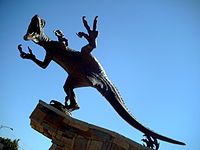- USU Eastern Prehistoric Museum
-
USU Eastern Prehistoric Museum
The iconic sentinel Utahraptor greets visitors in front of the USU Eastern Prehistoric Museum.Established 1961 Location Price, Utah Type Science, Natural History Director Kenneth Carpenter Website http://museum.ceu.edu The USU Eastern Prehistoric Museum, formerly known as the College of Eastern Utah Prehistoric Museum, is a museum accredited by the American Association of Museums located in Price, Utah. The museum seeks to promote public understanding of prehistory through interpretive exhibits, educational programs, collections, and research. The museum is located near many paleontological and archaeological sites in a region known as Castle Country, notably in the San Rafael Swell and nearby canyons throughout the Book Cliffs area such as Nine Mile Canyon and Range Creek Canyon.
Contents
History
 Mounted Utahraptor in the museum's Hall of Dinosaurs
Mounted Utahraptor in the museum's Hall of Dinosaurs
The Prehistoric Museum was established in 1961 as a cooperative effort by USU-College of Eastern Utah and the community of Price. On May 8, 1961 the Board of Regents established the museum. At that time funding for the museum was supplied by the geology department at the college. The museum officially opened to the public on June 3, 1961, on the second floor of the Price Municipal Building in a small converted conference room. After expanding into the hallways of the City Hall it moved into the old city gymnasium in 1971.
In later years, the museum became an appropriated line item through the State of Utah. In 1990-91, the appropriation for the museum was greatly increased because of the tremendous expansion of the museum. A new addition was opened, later to become the Hall of Dinosaurs.
Through these two separate expansions during its 45-year history, the museum has become a 25,000-square-foot (2,300 m2) facility with another 6,000-square-foot (560 m2) repository and paleontology preparation laboratory. An ongoing program of paleontology fieldwork and excavation begun in 1990 has produced 12 new species of dinosaurs and over 7,000 paleontologic specimens. Federal and state accreditation followed in 1991, allowing the museum to reposit collections from across Utah. Renewed interest in dinosaurs and a popular culture boom brought thousands more visitors down the Dinosaur Diamond Scenic Byway and to the museum in the 1990s.
New development in Utah and the renaissance in dinosaur research has resulted in huge new finds and exciting new levels of interest. The museum now serves as an important repository housing over 750,000 prehistoric specimens from around the state.
Features
The Museum's national accreditation by the American Association of Museums distinguishes it as fewer than 10% of museums awarded such accreditation. As a state and federal repository for both paleontological and archaeological collections, the museum’s holdings include more than 700,000 archaeological artifacts, comprising one of the largest and most significant collections in the country. Many of these artifacts, such as those left by the indigenous Fremont people, have become world-renowned. The Museum’s paleontological collection includes type specimens and fossil finds new to science. The Museum is a pre-eminent educational, research, recreational, and cultural institution in Southeastern Utah. The collections and exhibits focus on specimens indigenous to the region and include:
- Fremont culture exhibits such as rock art reproductions and the famous Pilling Figurines
- Comprehensive display of Utah’s Ice Age ecology and Paleoindian presence
- The Huntington Mammoth, best-known and one of best-kept of all fossil elephants
- Utahraptor and a dozen other new dinosaurs, several percent of known global diversity
See also
- Cleveland Lloyd Dinosaur Quarry — specimens collected from this location are on display at the USU Eastern Prehistoric Museum
External links
Utah State University Logan • Old Main • Merrill-Cazier Library • Smith Spectrum • Romney Stadium • Performance Hall • Jon M. Huntsman School of Business • Chase Fine Arts Center • Nora Eccles Harrison Museum of Art • USU Museum of Anthropology • George Nelson FieldhouseCenters Space Dynamics Laboratory • Utah Botanical Center • Swaner EcoCenter • Utah Water Research Laboratory • Prehistoric Museum • Institute of Frescography • Honors ProgramPresidents • Alumni • FacultyUtah State Aggies • Football • Men's Basketball • Big Blue • Fight Songs • Battle of the Brothers • Old Oquirrh Bucket • Western Athletic Conference • Athletics DirectorRegional Campuses USU-Brigham City • USU-College of Eastern Utah • USU-Tooele • USU-Uintah BasinOutreach Coordinates: 39°35′58.5″N 110°48′29″W / 39.599583°N 110.80806°W
Categories:- Dinosaur museums in the United States
- Natural history museums in Utah
- University museums in Utah
- Museums in Carbon County, Utah
- Institutions accredited by the American Association of Museums
- Utah State University
Wikimedia Foundation. 2010.

